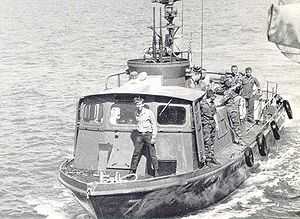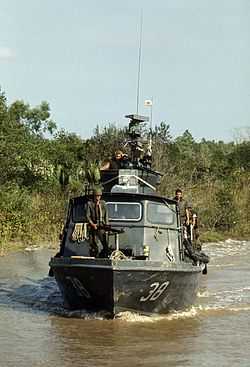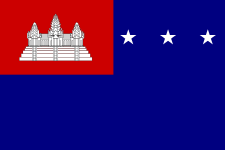Patrol Craft Fast



Patrol Craft Fast (PCF), also known as Swift Boats, were all-aluminum, 50-foot (15 m) long, shallow-draft vessels operated by the United States Navy, initially to patrol the coastal areas and later for work in the interior waterways as part of the brown-water navy to interdict Vietcong movement of arms and munitions, transport Vietnamese forces and insert SEAL teams for counterinsurgency (COIN) operations during the Vietnam War.
Development
Conception
The Swift Boat was conceived in a Naval Advisory Group, Military Assistance Command, Vietnam (NAVADGRP MACV) staff study titled "Naval Craft Requirements in a Counter Insurgency Environment," published 1 February 1965. It noted that "COIN water operations are difficult, demanding, and unique. A prevalent belief has been that COIN craft can readily be obtained from existing commercial and naval sources when needed. Unfortunately, no concerted effort has been made to develop COIN craft specifically suited to perform the many missions needed to combat insurgent activities."
The study went on to list characteristics of the ideal patrol craft:
- Reliable and sturdy
- Non-wooden hull, with screw and rudder protection against groundings
- Self-sufficient for 400 to 500 mile (600 to 800 km) patrol
- Speed of 20 to 25 knots (37 to 46 km/h)
- Small high-resolution radar range 4 to 6 miles (7 to 11 km)
- Reliable long-range communications equipment, compatible with Army and Air Force
- Quiet
- Armament for limited offense
- Sparse berthing, no messing
- Depth meter, accurate from 0 to 50 feet (15 m)
- Small, powerful searchlight
The study was positively received, and the Navy began to search for sources. Sewart Seacraft of Berwick, Louisiana, built water taxis for companies operating oil rigs in the Gulf of Mexico, which appeared nearly ideal. The Navy bought their plans, and asked Sewart Seacraft to prepare modified drawings that included a gun tub, ammo lockers, bunks, and a small galley. The Navy used those enhanced plans to request bids from other boat builders, but Sewart Seacraft was selected.
Mark I
_fast.jpg)
The Swift Boats had welded aluminum hulls about 50 feet (15 m) long with 13 feet (4.0 m) beam, and draft of about five feet (1.5 m). They were powered by a pair of General Motors 12V71"N" Detroit marine diesel engines rated at 480 horsepower (360 kW) each, with a design range from 320 nautical miles (590 km) at 21 knots (39 km/h) to about 750 nautical miles (1,390 km) at 10 knots (19 km/h). The normal complement for a Swift Boat was six: an officer in charge, a boatswain, a radar/radioman, an engineer, and two gunners. In 1969 the crew was supplemented with a Vietnamese trainee.
The first two PCFs were delivered to the Navy in late August 1965. The original water taxi design had been enhanced with two .50 caliber M2 Browning machine guns in a turret above the pilot house, an over-and-under .50-caliber machine gun – 81 mm mortar combination mounted on the rear deck, a mortar ammunition box on the stern, improved habitability equipment such as bunks, a refrigerator and freezer, and a sink. The 81 mm combination mortar mounted on the rear deck was not a gravity firing mortar as used by the Army and Marine Corps, in which the falling projectile's primer struck the fixed firing pin at the base of the mortar tube, but a unique lanyard firing weapon in which the projectile was still loaded into the muzzle. The gunner could "fire at will" by the use of the lanyard. The weapon had been tested in the 1950s, discarded as the U.S. Navy lost interest in the system. The United States Coast Guard maintained the gun/mortar system before the Navy incorporated it into the PCF program. Many boats also mounted a single M60 machine gun in the forward peak tank, just in front of the forward superstructure.
The original order for 50 boats was followed shortly by an additional order for 54 more Mark I's.
Mark II & III
In the latter half of 1967, 46 Mark II boats, with a modified deck house set further back from the bow. The newer boats also had round port holes (replacing larger sliding windows) in the aft superstructure. From 1969 through 1972, 33 Mark III's, which were a larger version of the Mark II's, arrived in Vietnam.
Use
Although 193 PCFs were built, only about 110 served in Vietnam and the two training bases in California; with remaining PCFs being sold or given to nations friendly to the United States. The original training base for Swift Boats had been at the Naval Base in Coronado, California, and in 1969 moved to Mare Island near San Pablo Bay, California where it remained throughout the Vietnam war. PCF training boats frequently transited from Mare Island, through the Golden Gate Bridge, then either north or south along the coastline. The only Swift Boat known to be lost while stationed at the new training base was PCF-8, when it sank during a storm off Bodega Bay, California in December 1969. No crewmen were lost.
Vietnam service

The first swift boats arrived in Vietnam in October 1965. Initially used as coastal patrol craft, their shallow draft and low freeboard limited their seaworthiness in open waters. These limitations, plus the difficulties being encountered in the interior waterways by the smaller, more lightly armed PBRs led to the incorporation of Swift boats to patrol the 1,500 miles of interior waterways of Vietnam.[1] Swift boats continued to operate along the Vietnamese coastal areas, but with the start of Admiral Elmo Zumwalt's "SEALORDS" riverway interdiction strategy, their primary area of operations soon centered upon the Mekong Delta area in the southern tip of Vietnam.
The delta was composed of ten thousand square miles of marshland, swamps and forested areas all interlaced by rivers and canal ways. Controlled by the Viet Cong, the interior waterways of the Mekong Delta were used to transport Viet Cong supplies and weapons.
Boats generally operated in teams of three to five. Each boat had an officer in charge, one of whom would also be placed in overall charge of the mission. Their missions included patrolling the waterways, searching water traffic for weapons and munitions, transporting Vietnamese marine units and inserting Navy SEAL teams.
When the swift boats began making forays up the waterways into the interior of the delta, they initially took the carriers by surprise, causing them to drop their materials and run off into the overgrowth. Occasionally a short firefight would break out. As it became clear that control for the waterways was being contested the Viet Cong developed a number of tactics to challenge the US Navy. They set up ambushes, built obstructions in the canals to create choke points, and began to place mines in the waterways.
For the swift boats, coming back down river was always more dangerous then going up river. The passage of a patrol assured their eventual return, providing an opportunity for the Viet Cong. Ambushes were typically short lived affairs, set up at a river bend or in a narrow canal that restricted the maneuverability of the boats.[2] A wide variety of portable weapons were used in attacks, including recoilless rifles, B-40 rockets, .50 caliber machine guns and AK-47s, often fired from behind earthen bunkered positions.[3] When attacked the boats would accelerate out of the hot zone, turn and then return as a group, firing as many of their .50 caliber machine guns as they could bring to bear as they powered past the ambush point, then returning across as many times as needed to reduce the ambushers. Though most cruising and patrolling was done at 8 to 10 knots, the boats could reach a top speed of 32 knots. Engagements were brief and violent, with the ambushers often slipping away into the undergrowth when the boats located the source of attack and began to concentrate their return fire. Thick brush and vegetation in the delta provided excellent cover for the escaping ambushers. Casualties taken among the river crews were high. Casualties suffered among the Viet Cong were difficult to assess, as they would take their dead and wounded away from a firefight. Discovering newly dug graveyards was one of the few ways to confirm Viet Cong losses.[4]
The first Swift Boat to be lost during the war was PCF-4, which was lost to a mine in 1966. Two boats, PCF-14 and PCF-76, were lost in rough seas at the mouth of the Cua Viet River near the DMZ, and a third, PCF-77, was lost in a rescue effort during a monsoon at the mouth of the Perfume River on the approach to Huế. All three of these boats were lost in 1966. PCF-41 was lost that same year in an ambush when it was hit by fire from a 57 mm recoilless rifle. Its controls destroyed and coxswain killed, it ran aground at speed. When the crew ran out of ammunition it had to be abandoned.[5] She was recovered the next day but was too badly damaged to be repaired. She was salvaged instead. PCF-43 was lost to a rocket attack in 1969.[6] Several other Swift Boats had been lost to river mines, but had been salvaged and either repaired or used for spare parts.
Events of June 1968

In June 1968, PCF-19 and PCF-12 were patrolling near the DMZ (17th parallel) when they were attacked by hovering aircraft at night time. Within minutes, PCF-19 had disappeared from an explosion, and PCF-12 commenced a running gun battle with its .50 caliber machine guns for well over an hour with those "hovering lights." During this battle, PCF-12 had been continuously radioing that they were under attack by unidentified aircraft (i.e., hovering aircraft). The response was a continuous one, "no friendly aircraft in the area". Further radio traffic informed PCF-12 that US Forces had suspended all flying operations within PCF-12's area, in order to isolate the problem.
However, the Swift Boat was still in contact (still engaged with the enemy). Hours elapsed, but still in darkness, U.S. jet aircraft responded to PCF-12's firefight, but bypassed them and headed for the Australian destroyer HMAS Hobart and the heavy cruiser Boston. The U.S. jets fired rockets killing two Australian sailors and slightly damaging the Hobart and the Boston. Parts of the recovered rockets had U.S. data on them identifying them as American. The hovering aircraft had also been seen by U.S. Marines on shore, near the DMZ, on the South side of the border. When all reports had been submitted, the attacks on the two allied warships were attributed to the US attacking fixed-wing aircraft (friendly fire), and also for attacking PCF-12 and destroying PCF-19.[7]
A primary complication, that helped to make the above conclusion, is that the battle between the Swift Boats and the unidentified hovering aircraft started between midnight and 0100 hours on 16 June, and the attacks on the Boston and Hobart occurred during the same time frame, only on 17 June. These were two separate dates, and, in reality, two separate incidents. When completed (the reports) both events had somehow been merged into one incident; again, fratricide. It had been theorized, by both officers and men (U.S. Army, USMC, USN) that the, "NVA helos were flying artillery,"[7] etc. to Tiger Island, located just off the North Vietnamese coast. However, it goes beyond theory, when official reports, such as OIC, PCF-12s Combat After Action Report dated "20 OCT 1967" (1968?) for "Market Time Patrol," "151130H JUN-161130H JUN 1968," mentions in part "...enemy held Tiger Island...possible base of operations for North Vietnamese military..." and "under constant air attack from all angles Helo...gunners ordered to fire the .50 caliber guns at any and all air contacts...."[7] There were more than enough declassified official reports that mention "enemy aircraft" to conclude that the loss of PCF-19 was due to North Vietnamese helicopters. It is important to note, however, that as of 2006, PCF-12 and PCF-19 were still carried by the US Navy as attacked/lost from friendly fire.[7]
In training
The most frequent training area for the Mare Island units was the marshland that forms the northern shoreline of San Francisco Bay. This area, now known as the Napa Sonoma Marshes State Wildlife Area, was also used by United States Navy Reserve unit PBRs (Patrol Boat, River) up until 1995, when Mare Island was scheduled for base closure. During those years in which the Swifts and PBRs were operating, motorists traveling along Highway 37 from Vallejo, which passes Mare Island, to the Bay Area would often see the Riverine Boats making their way through the various sloughs of the current wildlife area. U.S. Naval Riverine Training is still authorized in the waters of the State Wildlife Area, and portions of the TV History Channel Series Gunboats of Vietnam, were filmed there.
In service of the Vietnam People's Army
The Vietnam People's Army managed to receive a number of defunct South Vietnam's PCFs after the unification of Vietnam in 1975. The PCFs were quickly used in the PAVN's operation at Thổ Chu and other islands to repel the invasion of the Khmer Rouge. The swift boats are still active in the current Vietnam army.[8]
Operators
 United States - U.S. Navy
United States - U.S. Navy Philippines - Philippine Navy, Philippine Coast Guard[9]
Philippines - Philippine Navy, Philippine Coast Guard[9] South Vietnam - Republic of Vietnam Navy
South Vietnam - Republic of Vietnam Navy Khmer Republic - Khmer National Navy
Khmer Republic - Khmer National Navy Khmer Rouge, captured from the US Navy and Khmer National Navy
Khmer Rouge, captured from the US Navy and Khmer National Navy Thailand - Royal Thai Navy
Thailand - Royal Thai Navy Malta - Maritime Squadron of the Armed Forces of Malta
Malta - Maritime Squadron of the Armed Forces of Malta Panama - SENAN
Panama - SENAN Vietnam - Vietnam People's Army, taken from the former South Vietnam Navy
Vietnam - Vietnam People's Army, taken from the former South Vietnam Navy
Current

The Mediterranean island nation of Malta was one of the last operators to make use of two Swift Boats in the Maritime Squadron of the Armed Forces of Malta (AFM). The Swifts were built at the time of the Vietnam war, with the two vessels used in Malta having started their life as training vessels. These craft, transferred by the US government in 1971 when Dr. George Borg Olivier was still Prime Minister, carried hull numbers C23 and C24 respectively (later renamed P23 and P24) and, while somewhat modified, maintained the look of the original riverine warfare boats. The two small inshore patrol boats became the work horses of the AFM's Maritime Squadron and were only retired once four new Austal patrol boats were commissioned in 2011. Former U.S. Navy Vietnam veterans, from the Swift Boat Sailors' Association, visited Malta in 2010 and said the Malta Swifts were the last two still in service, out of hundreds that were built.[10] One of the two patrol boats headed back to the United States to become a memorial in summer 2012 at the Maritime Museum of San Diego in California. The museum has a display paying tribute to the Maltese servicemen who died on board the P23 (the sister vessel of P24) during an accident that occurred on September 7, 1984. The incident – known as the C23 tragedy and the worst peace-time accident suffered by Maltese services personnel – killed five AFM soldiers and two policemen when illegal fireworks about to be dumped into the sea exploded on the bow of the small patrol boat. The AFM retained P23 as a memorial to those killed in the explosion.[11] P23 was also depicted on a Maltese postage stamp commemorating the island's maritime heritage on 10 August 2011.[12]
The captured Swift boats are still active in the Vietnam People's Army, although their sheer age prompts the Vietnamese army to carry out several modernizations. For example, the old American M2 machine gun was replaced by domestic-produced NSV ones which are more reliable and easier to maintain. The communication and electronic system was also overhauled.[8]
The only operational PCF in the United States today is the R/V Matthew F. Maury operated by Tidewater Community College in Virginia Beach, Virginia. Formerly PCF-2, the vessel was awarded to the college in 1995 and has been engaged in oceanographic research and education since then. The R/V Matthew F. Maury is berthed at JEB Little Creek and operates in and around Chesapeake Bay.
There are two Swift Boats preserved in static displays in the United States. Both are former U.S. Navy Swift Boats that were originally stationed in California to train PCF crews. One is located at the Navy Museum at Washington Navy Yard in Washington, D.C.;[13] the second Swift Boat is on the Naval Special Weapons Base at Naval Amphibious Base Coronado, California, the original home of PCF training.
United States Secretary of State John Kerry served aboard Swift Boats for approximately four of the 16 months he served in Vietnam.[14] LTJG Kerry was awarded the Silver Star and three Purple Hearts during riverine combat in a PCF. As the Democratic nominee for president in 2004, then-Senator Kerry made his military service a key component of his campaign. A 527 group called Swift Boat Veterans for Truth formed to challenge Kerry on his record. Crewmembers who served under Kerry's command disputed the group's charges and supported the senator's claims. Kerry campaign operatives derided the claims of the Swift Boat Veterans for Truth, creating the term "swiftboating," to mean a type of ad hominem smear campaign. The term has since entered American political jargon equating swift boat service with smear tactics. In an article in the New York Times on June 30, 2008, Swift Boat veterans objected to the prevalent use of the verb "swiftboating" as this type of ad hominem attack, stating that it is disrespectful to the men who served and died on the PCFs during Vietnam.[15]
See also
- Patrol Boat, River, PBR, 32-foot (9.8 m) long, all fiberglass boat, with twin water jet propulsion, used on rivers.
- Mobile Riverine Force
- Operation Market Time
- Brown-water navy
- Littoral combat ship
- Boghammar
- Harbour Defence Motor Launch
- Small unit riverine craft
Notes
- Citations
- ↑ Symmes War on the Rivers p. 95
- ↑ Symmes War on the Rivers p. 148
- ↑ Symmes War on the Rivers p. 136
- ↑ Symmes War on the Rivers p. 173
- ↑ "Coastal Squadron One; 22 May 1966 Sinking of PCF-41 by CDR Lawrence J. Wasikowski Retired - taken from http://swiftboats.net".
- ↑ Symmes War on the Rivers pp. 120-122
- ↑ 7.0 7.1 7.2 7.3 Steffes, James (2005), Swift Boat Down: The real story of the sinking of PCF-19, Xlibris, ISBN 1-59926-612-1
- ↑ 8.0 8.1 Khám phá vũ khí mới trên tàu PCF VN sau nâng cấp (Vietnamese)
- ↑ "PCG Ships and Auxiliaries". Retrieved 2014-04-23.
- ↑ "Veteran patrol boat to head back to the US". Times of Malta. 10 January 2012. Retrieved 15 August 2012.
- ↑ "Updated: Patrol boat explosion tragedy recalled". Times of Malta. 7 September 2009. Retrieved 15 August 2012.
- ↑ "Maritime Stamp issue by MaltaPost". The Malta Independent. 28 August 2011. Retrieved 27 April 2014.
- ↑ "PFC 1". Historic Naval Ships Association.
- ↑ Bowers, Andy (25 August 2004). "What, Exactly, Is a Swift Boat?". Slate.com. Retrieved 13 September 2004.
- ↑ Zernike, Kate (2008-06-30). "Veterans Long to Reclaim the Name 'Swift Boat'". The New York Times. Retrieved 2010-03-27.
- References cited
- Friedman, Norman U.S. Small Combatants: An Illustrated Design History, United States Naval Institute, 1987 ISBN 0-87021-713-5.
- Steffes, James Swift Boat Down: The real story of the sinking of PCF-19, Xlibris, 2005 ISBN 1-59926-612-1
- Steffes, James "Operation Market Time, The Early Years, 1965-66", Xlibris, 2009, ISBN 978-1-4415-9049-7
- Symmes, Weymouth War on the Rivers: A Swift Boat Sailor's Chronicle of the Battle of the Mekong Delta Pictorial Histories Publishing Company, 2004. ISBN 1-57510-109-2
External links
| Wikimedia Commons has media related to Fast Patrol Craft. |
- PCF-45 story, by Robert Shirley
- Swiftboat development by CDR Lawrence J. Wasikowski Retired - taken from http://swiftboats.net
- Swiftboat specifications by CDR Lawrence J. Wasikowski Retired - taken from http://swiftboats.net
- HNSA Ship Page: Swift Boats to visit as museums and memorials
- Swift Boat Photos of the Swift Boat at the US Navy Museum in Washington, DC
- Swift Boat Sailors' Association